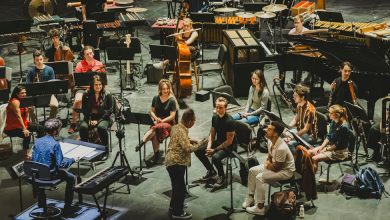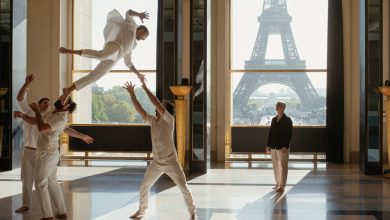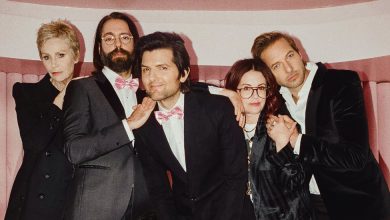What Is American Music? Three Classical Albums Offer Answers.

What is American classical music, exactly? When crafting their answers, programmers have historically chosen one of two approaches: cautious, piecemeal efforts or risky, all-in-one fusion.
The piecemeal strategy could concede that items by jazz composers like Duke Ellington needed to be in the mix, but as a separate concert or album, rather than with the fully notated and regularly played works of Gershwin or Bernstein. The fusion approach has been heard far less frequently. But it existed. In 1976, the American pianist Frederic Rzewski gave listeners an inventive mélange of two different notated piano pieces by saxophonist and improviser Anthony Braxton — plus a sonata by the German-born composer Hanns Eisler and his own “No Place to Go but Around” — in one dizzying recital.
This concept, once experimental, is now one that the classical mainstream occasionally reaches to embrace, as on a recent album by the violinist Daniel Hope, “America.” The experimentalists still do fusion, too — as on the string quartet PUBLIQuartet’s new release, “What Is American.” A third route — of commissioning entirely new music — is demonstrated in yet another recording, the violinist Johnny Gandelsman’s three-disc, sprawling “This Is America,” out July 1.
Hope’s album is evidence that the fusion approach isn’t necessarily an easy one. On his recording, released earlier this year on the Deutsche Grammophon label, he gamely attempts Sam Cooke’s “A Change Is Gonna Come” as well “Come Sunday,” from Ellington’s “Black, Brown and Beige.” (Mainstays of a more narrowly framed American repertoire, such as works by Bernstein and Copland, are also on the program.)
In the Cooke, Hope’s tone is pleasant enough — if a touch too pallid to match the soulfulness of Joy Denalane’s vocals. But the Ellington excerpt is a missed opportunity, with an opening sped through too breezily.
Judge this reading against an Ellington recording from 1958 in which the violinist Ray Nance revels in the same melodic material for 10 additional seconds, after his entrance. There’s a reason you don’t fast-forward through phrases; the extra seconds can turn out to mean everything.
On Hope’s album, the best performances come early, when he takes on a clutch of Gershwin tunes. Here, he invites a trio led by the pianist Marcus Roberts to help with improvisations and the swinging American idiom. Their participation inspires some spirited playing from Hope, whose tone dances jauntily during “Fascinating Rhythm.” (He also plays bluesy double-stops over the drummer Jason Marsalis’s rhythms toward the end of “Summertime.”)
Yet the collaboration among Hope, the Zurich Chamber Orchestra and the Roberts Trio remains unstintingly polite, with the latter noticeably hemmed in. It’s a far cry from the energy of a 2003 Berlin Philharmonic performance led by Seiji Ozawa, streaming on that ensemble’s Digital Concert Hall, in which the Roberts Trio was engaged for a daring, push-and-pull reading of Gerswhin’s Concerto in F.
“America” seems to be aware that this might be a problem. On the cover, Hope is seen wearing a vest and tuxedo, and leaning against a vintage car parked in front of a building whose windows are decorated with portraits of American musical greats. But the artists photoshopped into those window frames don’t quite track with the album’s sound. There’s not a single passage that has the explosive quality of the saxophonist and bass clarinetist Eric Dolphy’s ecstatic hopscotching among registers and timbres. So what is he doing in the album art?
Beyond his own music, Dolphy appeared as a key soloist in Civil Rights-era musical essays by the bassist and composer Charles Mingus, particularly in “Original Faubus Fables” and “Meditations on Integration.” Yet the protest poetry of Dolphy, and of John Coltrane — another artist pictured on the cover of “America” — isn’t present here beyond the title of Cooke’s change-promising pop song.
As a result, Hope’s album doesn’t musically face the roiled state of the union head-on, or acknowledge past revolutions within this country’s continuously evolving jazz tradition. The fiery music that Coltrane and Dolphy played in 1961 was critiqued at the time as being “anti-jazz” in some quarters — a take that hasn’t aged well. But while Hope seems eager to cite the fire of American ingenuity on an album cover, he doesn’t want to get singed by it in practice.
The opposite holds true for long stretches of Gandelsman’s “This Is America” project, an ambitious set that attempts to take the national temperature by soliciting new solo works from a group of a couple dozen composers. In his liner notes for the album, the violinist cites a bevy of issues as inspirations for his impulse to commission these pieces: the pandemic; police violence and the deaths of Ahmaud Arbery, George Floyd and Breonna Taylor; the over four million acres of California’s forests lost to wildfires in 2020; unemployment; “vicious election cycle rhetoric.”
Many of the composers responded to Gandelsman’s prompt with a similar sense of overwhelming dread and sadness. Fair enough. But as a listening experience, the nearly four-hour program could have used more works like “Sahra be Wyckoff,” by the Syrian-born clarinetist and composer Kinan Azmeh. Written for a time when it was difficult for friends and artistic collaborators to assemble, it recalls a more joyous past of jam sessions in Brooklyn. Gandelsman’s intoxicating performance sent me back to Azmeh’s impressive 2021 album “Flow,” recorded with the NDR Bigband, from Germany. That set is another example of the capacious mutability of American energies — with Ellingtonian orchestration fusing with melodic modes from the Middle East.
Otherwise, the pieces Gandelsman received trend toward gloomier moods and topics — including a memorial to a dead friend and multiple meditations on civic strife. And some pieces reflect composers’ long-established preoccupations. So when Tyshawn Sorey offers the contemplative (and sometimes ferocious) “For Courtney Bryan,” the miniature can serve as a small but important addition to the composer’s quickly expanding catalog of prismatic tributes to his musical contemporaries. But “For Courtney Bryan” is only slightly engaged with Gandelsman’s stated hope that the commissions “reflect in some way on the time we were all living through.” (For Sorey’s more specific thoughts on our moment, you might turn to his searing “Save the Boys,” from last year.)
Still, it’s all exactingly played; Gandelsman is attuned to the precise nature of each artist, and tailors his sound to each one. The second disc offers a rush of compositional contrast and interpretive effort. There, you’ll find Angélica Negrón’s dreamy ode to childhood stargazing (“A Través del Manto Luminoso”), where Gandelsman’s piping, direct sound merges ideally with the electronic backing track.
Ebun Oguntola’s somber yet mysterious “Reflections” spurs Gandelsman toward contrasts of bow pressure, suggesting unpredictable twists of an individual’s mind. On Tomeka Reid’s singing-then-virtuosic “Rhapsody,” his dynamic shifts are more fluid in nature — and quietly impressive. And Gandelsman brings a charming, free-associative quality to his performance of Terry Riley’s episodic “Barbary Coast 1955.”
The kaleidoscopic invention in those works courses throughout PUBLIQuartet’s “What Is American,” my favorite classical album of the year thus far. It contains winning arrangements of Dvorak, as well as of Tina Turner’s “Black Coffee” and the Ornette Coleman tunes “Law Years” and “Street Woman.” There’s a head-nodding performance of Vijay Iyer’s string quartet “Dig the Say” (itself inspired by James Brown).
And there is a newly commissioned string quartet, “CARDS 11.11.20,” from Roscoe Mitchell — the composer-saxophonist who came to prominence in the 1960s, alongside Braxton and other members of the Association for the Advancement of Creative Musicians. Like other works in Mitchell’s “Cards” series, this through-composed effort invites improvisation (with musicians allowed to shuffle fragments of the score, at one point in the performance); the PUBLIQuartet players sound at home inside this peculiarly American challenge.
Snaking among those and other works are the quartet’s fractured recitations of Oliver Wendell Holmes Sr.’s obscure fifth verse to “The Star-Spangled Banner.” Amid the Civil War, this poet — and the father of the Supreme Court Justice Oliver Wendell Holmes Jr. — excoriated “the traitor that dares to defile / The flag of her stars and the page of her story!” (Think of that in the context of the Jan. 6 rioter who carried the Confederate flag inside the U.S. Capitol building, and who was recently convicted of a felony and four misdemeanor offenses.)
Never overstuffed, “What Is American” contains fun, eclecticism and civic engagement within the length of a single CD. The album’s ability to weave multiple traditions reaches an early peak in its radical yet recognizable adaptation of Dvorak’s String Quartet No. 12 — nicknamed the “American” in part because of its affection for, and inspiration from, Black American musicians like Harry Burleigh (as well as Indigenous American melody).
We have dozens of pristine, score-accurate renditions of this war horse; the PUBLIQuartet players have rightly intuited that it can withstand a bit of reinvention. Their performance represents, they note, “improvisations” on the work. They practically draw and quarter the opening movement’s first and second themes, introducing or elaborating on them with scratchy, rough-hewed accents.
Before the movement’s closing recapitulation of those themes, the players give us a spine-tingling moment. Having completed their version of the development, they execute a tempo downshift before collectively improvising in a blues mode with broad appeal.
Seconds later, when the group turns back toward Dvorak’s own American-inspired sound, there’s a fresh idea absent in other albums with similar aspirations: a suggestion that group dynamics, as much as individual interpretations, are essential to American music. It won’t solve the country’s problems, but as definitions of the contemporary American spirit go, it’s the recording I’ll be playing for loved ones come this Fourth of July.





